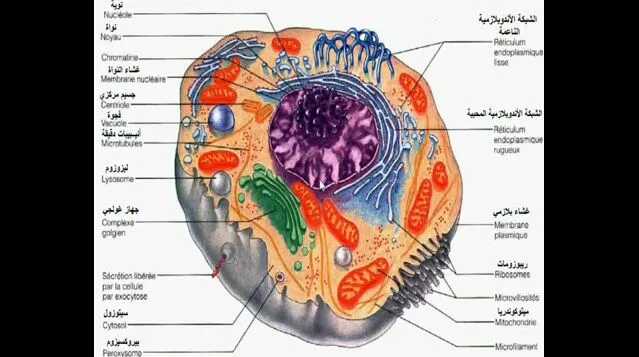Cell theory
The cell theory was extended by Virchow (1855) according to which a cell comes from a preexisting cell by division and can not be formed by spontaneous generation.
In the light of observation techniques and biochemical analyzes, the cell can be defined as:
a highly organized system of molecules: water, mineral salts, proteins, lipids, carbohydrates and nucleic acids.
Molcules are organized into defined structures.
Example: Ribosome = proteins + nucleic acid (rRNA)
Plasma membrane = proteins + carbohydrate lipids.
These structures are able to use the material and the energy of the environment with the aid of chains of reactions: METABOLISM
METABOLISM: catabolism + anabolism
catabolism: degradation activity
anabolism: activity of synthesis
consequences of these reactions: the system can develop, reproduce and adapt to the conditions of the environment in which it lives.
أصل الخلية
نظرية الخلية
تم تمديد نظرية الخلايا بواسطة Virchow (1855) والتي بموجبها تأتي الخلية من خلية موجودة مسبقًا بواسطة الانقسام ولا يمكن تكوينها بواسطة جيل تلقائي.
في ضوء تقنيات الملاحظة والتحليلات البيوكيميائية ، يمكن تعريف الخلية على النحو التالي:
نظام عالي التنظيم من الجزيئات: الماء والأملاح المعدنية والبروتينات والدهون والكربوهيدرات والأحماض النووية.
يتم تنظيم الجزيئات في هياكل محددة.
مثال: ريبوسوم = بروتينات + حمض نووي (rRNA)
غشاء البلازما = البروتينات + الدهون الكربوهيدراتية.
هذه الهياكل قادرة على استخدام المواد والطاقة في البيئة بمساعدة سلاسل من ردود الفعل: METABOLISM
METABOLISM: تقويض + استقلاب
تقويس: نشاط التحلل
استقلاب: نشاط التوليف
نتائج هذه التفاعلات: يمكن للنظام تطوير وإعادة إنتاج والتكيف مع ظروف البيئة التي يعيش فيها.